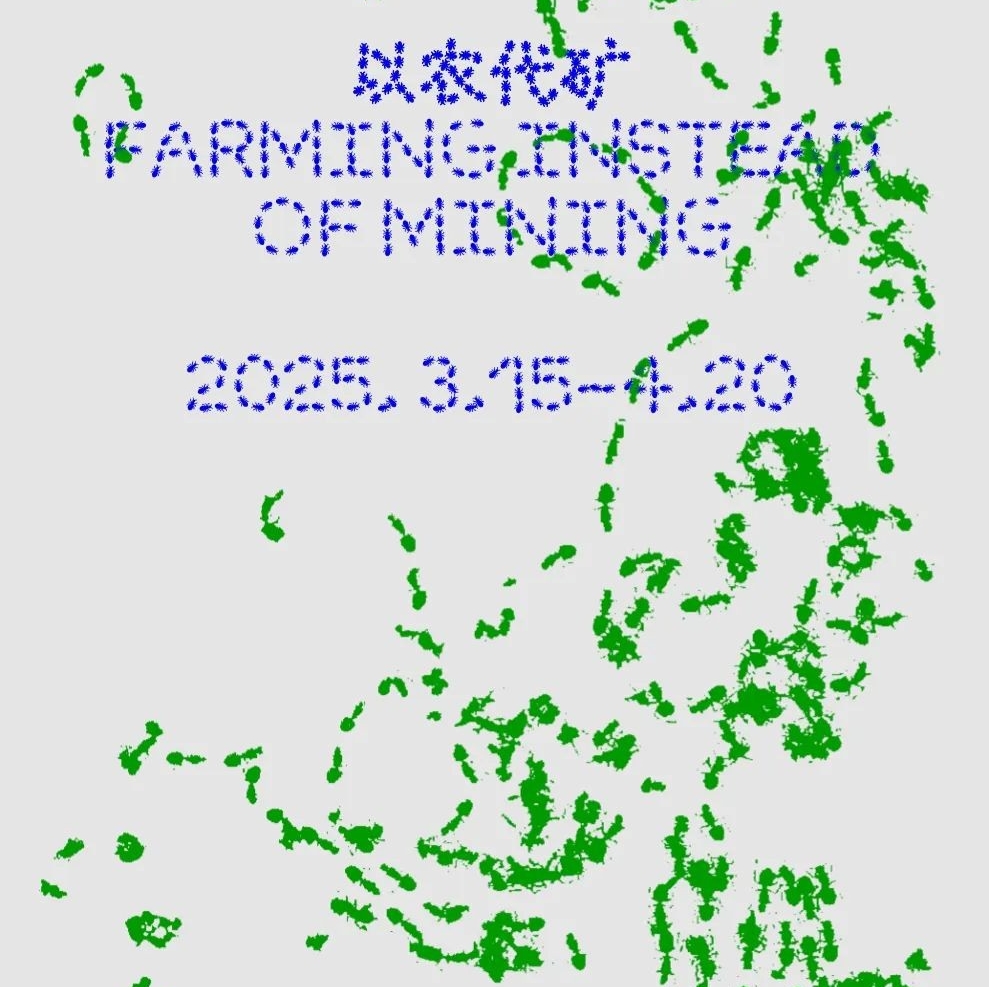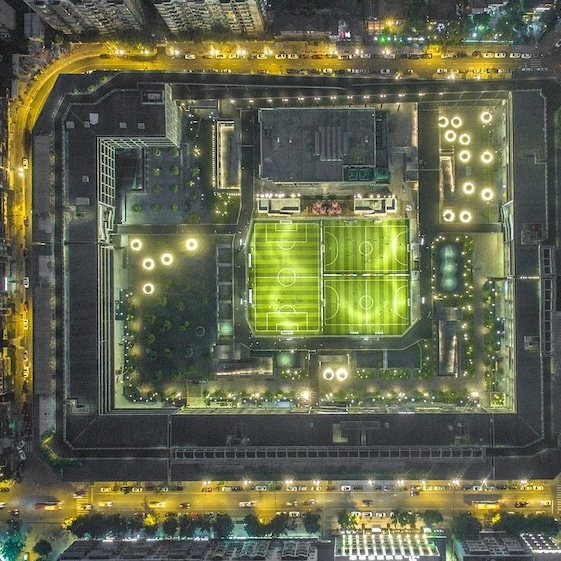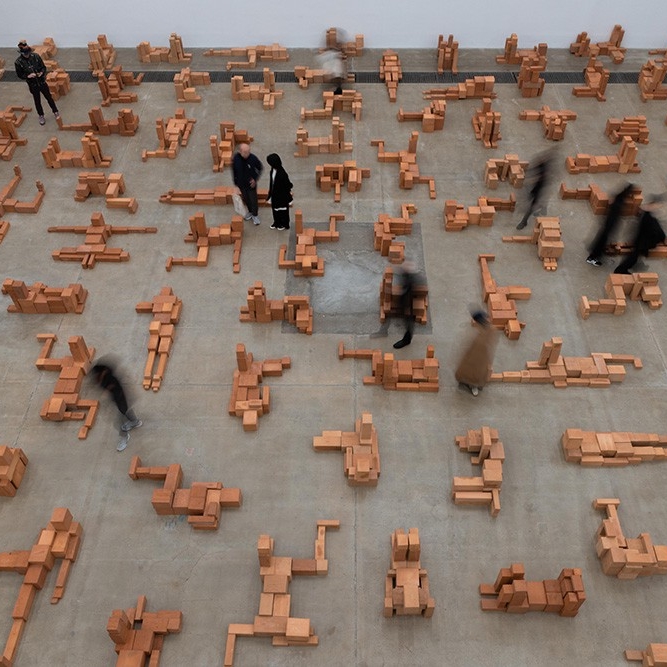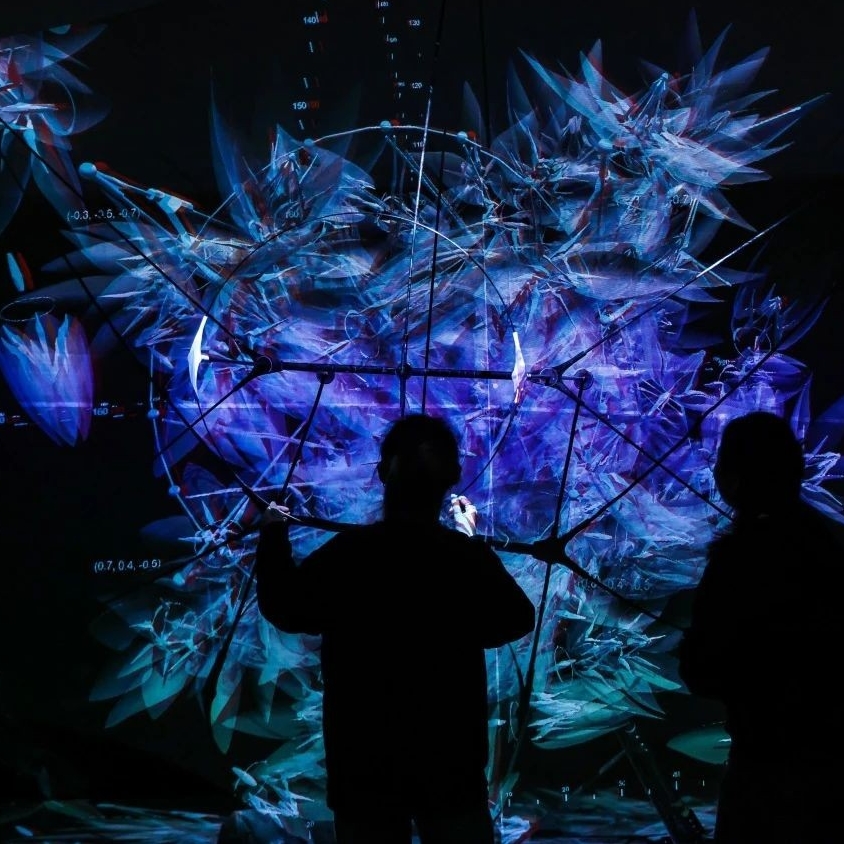 Hyundai Motorstudio Beijing presents Metamorphic Ecosphere, the second exhibition of Hyundai Blue Prize Art + Tech 2023, curated by ZONG Xiao.
Hyundai Motorstudio Beijing presents Metamorphic Ecosphere, the second exhibition of Hyundai Blue Prize Art + Tech 2023, curated by ZONG Xiao.
The Hyundai Blue Prize Art + Tech is an annual prize recognizing and supporting emerging curators in China and committed to fostering innovative and critical exploration of major contemporary issues. As its theme for 2023, “Decentralized Reworlding” encourages curators to investigate the complexity of the social system and rethink the current boundaries of our social norms and human territories in terms of envisioning the possibilities of reshaping the world. Metamorphic Ecosphere proposes “metamorphosis” as a methodology for humankind’s introspection, analysis of the economic and ecological structures in which we find ourselves, and examination of the inequalities that manifest through “voluntary” and “forced” metamorphoses.
The exhibition is developed based on the following premise:”Perhaps only through conceiving and welcoming the metamorphoses of our bodies, living spaces, and ecosystems can we truly embrace the ‘encroachment’ of other species and substances — and, in turn, stride towards a decentralized world.” The exhibition collaborates with ten emerging groups of artists to explore and experiment on this topic through various mediums. The theme is investigated through two aspects: “voluntary” and “forced” metamorphoses. As a mechanism for survival, voluntary metamorphoses test our tolerance for the transmutations of our bodies and draw attention to the possibilities of co-existing or even co-evolving with “invasive” species. Forced metamorphoses focus on the alteration of the planet’s metabolism as a result of technological progress and encourage reflection on the profound impact human activities have inflicted upon the environment.
"Under the theme of the Hyundai Blue Prize Art + Tech 2023, 'Decentralized Reworlding,' Metamorphic Ecosphere proposes metamorphosis as a crucial aspect of a decentralized ecosystem," stated DooEun Choi, the art director of Hyundai Motor. "The exhibition will encourage the creative and critical processes of reimagining our world in order to reflect on our shared planetary concerns for a better future."
The curator, ZONG Xiao, stated, “The advancement of technologies has drastically altered the planet’s metabolism, and the resulting metamorphoses of nonhuman agents constantly remind us of the cruelty and inequality of industrialization and technological development. Metamorphic Ecosphere encourages viewers to reconsider such metamorphoses and reflect on our relationships to technologies, as such reflections may be prerequisites for the creation of alternative social and ecological orders.”
The exhibition will be open to the public from November 4, 2023 to March 31, 2024, and will be accompanied by a series of public events. More information will be released through the official social media channels of Hyundai Motorstudio Beijing.
About the Artworks
 SO Wing Po
SO Wing Po
From the Body to the Body Through the Body, 2019
Corn silk, thread, iron, sound, motors
630 x 1170 x 378 cm
This work is made from dried corn silk, meticulously hand-combed and arranged by the artist to create an organic cocoon, allowing light and scent to pass through. The cocoon chamber is a space for "metamorphosis" to occur, with its gentle breathing and tender envelopment of inner life, encouraging transformations to take place within. The cocoon chamber welcomes people to step inside, promoting connection and togetherness, encouraging change and care. Those who pass through it will not be trapped within, but instead will be able to perceive the power of metamorphosis.
 DAI Shengjie
DAI Shengjie
Lunch at Treasure Island, 2023
Mixed media
Commissioned Work
Electronic waste is a metabolite unique to our current technological era. How are they processed, “digested”, “excreted”, and recycled? What is the internal structure, distribution, and who are the participants of this massive disposal system? We are eager to try out various state-of-the-art electronic products, but rarely do we concern ourselves with how those obsolete products are metabolized. The process of their transformation, as well as the way the entire metabolic system functions, constantly reveals the inequality inherent in technology and the absurdity of a technology-driven, decentralized world.
In Lunch at Treasure Island, the artist likens self-collected electronic waste, car components, and "undigested" chemicals to the circulation of food in the human body. It reveals their journey from production centers to the "shadows of the world," undergoing processes of cleansing, dismantling, and degradation into basic elements and chemical forms. By examining the intense economic labor, infrastructure configuration, and spatial planning of various waste collection sites, the artist attempts to portray a "medium afterlife" intricately intertwined with labor and community livelihoods. The artwork also delves into the destination of electronic media after its lifespan is depleted, the environmental burdens and new value created through the process, and the construction of new communities and cultures. The work aims at provoking introspection among viewers regarding resource circulation, ecological conservation, and the impacts of globalization, and at prompting a reevaluation of the interaction between human activities and natural forces, as well as the constitution of data-driven economies and their implications on political spaces.

Sustainable Platform:
XIAO Liang, GAN Yizhen, JIN Shengxu,
HUANG Jiayang, WANG Jingzhe
Plant Autonomy, 2021
Video
2'30''
"Plant Autonomy" attempts to integrate biology, materials science, and parametric methods to predict the survival trends of plants as intelligent beings. Through digital art, it presents the possibility of plant root systems becoming sustainable materials and transportation carriers, highlighting the sense of sovereignty that plant ecosystems hold over human-made landscapes. It envisions a future where plants have autonomous survival spaces.
Can humans relinquish their anthropocentric mindset of wanting to intervene and control plants to make them conform to human ideals of survival? Can we try to accept the "invasion" and "occupation" of our living spaces by plants?

XIAO Liang, GAN Yizhen
Rhizome Formation, 2023
Furniture
2000 x 500 x 550 mm;
880 x 690 x 600 mm
Through the organic combination of various media, the work aims to construct an independent symbolic system for plants. The artists attempt to simulate digital biological manufacturing, scaling up the cultivation of plant root systems. This process transforms plants' natural growth into furniture modules that people interact within their daily lives. The work raises the question that how, and can people come to understand plant instincts through multisensory experiences?

WANG Sicheng
Beginning and Future, 2023
Iron, PVG, stainless steel, photosynthetic bacteria,
algae, surgical forceps, oxygenators, pumpers
D Variable
The existence of photosynthetic organisms can be traced back to the beginning of life on Earth. They are a group of organisms with the unique ability to synthesize or decompose organic matter by converting light energy into chemical energy through the process of photosynthesis. As the earliest forms of life on Earth, they synthesized organic matter and released oxygen through photosynthesis, which eventually led to an increase in the amount of oxygen in the atmosphere on Earth, creating favorable conditions for the later evolution of life in all its complexity and diversity. Amidst worsening environmental problems, photosynthetic organisms provide mankind with an alternative source of energy to fossil fuels. They also contribute to mitigating climate change and reducing air pollution in light of global warming by sequestering carbon. In addition, using photosynthetic organisms as a tool to provide solutions for agricultural production as well as food safety is also an avenue that could be explored through the research and application of photosynthetic organisms, as they are also capable of regulating their photosynthetic efficiency. The work "Beginning and Future" is an on-site specific installation, utilizing the structure of the "Light Cone" to facilitate the incubation of photosynthetic bacteria and algae as the biological materials for this installation, which is a reflection on current global warming and energy crises.

WU Ziyang, Mark RAMOS
Networked Ecosystem, 2021
Interactive Live Simulation
In Networked Ecosystem, natural phenomena have been replaced by digital and artificial systems as forces that drive development: Electricity/battery = sustenance, WIFI signals = nutrition, Lidar data = fire/heat. Data organisms populate this digital ecosystem as native life forms in the form of bots, AI’s, and avatars. Visitors to this networked landscape develop new kinds of digital senses to experience data as environmental changes, and interact with the simulated world and each other in an ever-changing online environment.
This work imagines an ecosystem that is entirely based online and centered on data. From the perspective of a lifeform within the system, the work tries to analyze, interact and comprehend this world.

WANG Juju
intrusion, 2022
Installation
Where is the boundary between elegance and ugliness, and the boundary between creation of human and the great nature? Does the everywhere-intrusion of human existence always seem so politically correct? We were edu- cated so often that when humans leave, nature will take over. But was it us who took advantage of the nature in the first place?
The pearl necklace, a well-known piece of jewelry, derives its raw materials from nature and is transformed through human processing into a product that aligns with people's aesthetics. It is assigned with the role of adding "beauty" to people. The artist grows moss on the pearl necklace, allowing the moss to gradually invade and cover the "artificial beauty." The aesthetic presented by this "invasion" questions the righteousness of human arrangements and assigned purposes.
LIU Jiaying
Yap721, 2021
Stone Sculpture
190x152x270cm
Inspired by the FEI stone of the Yap island in Micronesia, the artist made this sculpture and engraved it with the hexadecimal code of genesis block of bitcoin on one side, and each collector’s web address on the other side. In the past, the ownership of a FEI stone is almost exclusively dependent on oral history, since the object itself is very difficult to move. Adopting the same idea, Yap721 encouraged people to think about the form of ownership, and the very concept of currency, especially in the digital universe. The stone coin itself symbolizes one of humanity's earliest attempts at decentralization. Its very existence also challenges the assumption that technological advancement is a necessary condition for decentralization.

YANG Yiming
Splice, 2020
Installation
In this work, the artist speculates on a posthuman era when technologies are so advanced that people could choose the form of their bodies. Human become a combination of organism, machine and information, and memories, experiences could be replicated and designed. When our essence, if we do have such a thing, could be replaced, the boundaries between human and non-human would diminish. How do we comprehend and handle our relationship with nature, technologies, other life forms. Our sensitivity to the boundary that defines what it means to be "human," as well as our boundless fears about the potential replacement of humans by machines and artificial intelligence in the future, might indeed reveal that human-centrism remains the "righteousness" in our hearts.

CAO Shuyi
【】, 2023
Video
【】
Commissioned Work
This work contemplates the entangled transmutation between geologic and biologic matters through planetary evolution and human extraction. Merging microscopic imaging and digitally constructed animation, the fictional scenes imagine the metamorphosis of the mineral element from primordial broth to interspecies coexistence. Audiences are invited to navigate through enigmatic strata and terrains alluding to ancient ecosystems with speculative fossils across lifeforms, as well as the geotrauma and future remains such as mining infrastructures, waste deposits, and Earth’s sinking holes.
The process of minerals transforming from elemental forms to industrial products, and eventually being discarded as waste into the natural environment, is directly linked to industrialization and technological advancement of the human society. Various elements deemed "useful" by modern technology are compelled to participate in planetary technological metabolism, constantly being synthesized, dismantled, excreted, and recycled, while the biological and geological environments they inhabit are destroyed and abandoned in this process. The constant transformation of minerals incessantly underscores the brutality and inequality of industrialization and technological development, while also seemingly foreshadowing the uncertainty of humanity's own future metamorphosis.
About the Exhibition
Metamorphic Ecosphere
Duration: November 4, 2023 – March 31, 2024
Venue: Hyundai Motorstudio Beijing, E-1, 798 Art Zone, 4 Jiuxianqiao Road, Chaoyang District, Beijing
Curator: ZONG Xiao
Participating Artists: CAO Shuyi, DAI Shengjie, JUJUWANG,Sustainable Platform (XIAO Liang, GAN Yizhen, JIN Shengxu, HUANG Jiayang, WANG Jingzhe), CryptoZR, SO Wing Po, WANG Sicheng, WU Ziyang & Mark RAMOS, XIAO Liang & GAN Yizhen, YANG Yiming
About the Curator

ZONG Xiao, graduated from the School of Visual Arts and obtained a Master’s Degree in Curatorial Practice. Zong has curated several exhibitions, including Narratives, Stories, Algorithms: Rethinking Independence in Digital Times, 2022, at the Pfizer Building, Brooklyn, New York, and LovingHatingLand, 2021, at the SVA Gallery, New York. She is a curator currently based in Shanghai.
About Hyundai Motorstudio
Hyundai Motorstudios are brand experience spaces that reflect the company's artistic spirit and experimental approach to art, design, and technology. This is where "motor", a word used in the automobile industry, and "studio", a word used to describe a space for contemplation and creation, meet in a manner accessible to the public.
For more information about Hyundai Motorstudio Beijing, please visit the official website of Hyundai Motorstudio Beijing.
About Hyundai Blue Prize Art + Tech
Launched by Hyundai Motor Company and Hyundai Motorstudio Beijing in 2017, The Hyundai Blue Prize has explored on“Social Mobility” (2018), “Future Humanity” (2019), “Social Intelligence” (2020), “Resonant Cities” (2021), “Disruptive Future” (2022), and “Decentralized Re-Worlding” (2023). Hyundai Blue Prize Art + Tech have recognized and supported emerging curators in China, fostering innovative and critical exploration of major contemporary issues. The website serves as a digital archive for the previous projects.
Disclaimer: Hyundai Motor Company believes the information contained herein to be accurate at the time of release. However, the company may upload new or updated information if required and assumes that it is not liable for the accuracy of any information interpreted and used by the reader.
Courtesy of Hyundai Motorstudio Beijing.





























